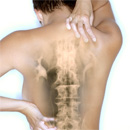

 As the population ages, diseases of bones such as osteoporosis and arthritis will become significant health problems. Joint stiffness and inflammation can interfere with normal activities which can have an impact on your overall quality of life. It is vital that we look at ways in which to protect our bone health to prevent joint stiffness and inflammation that is commonly reported in the elderly.
As the population ages, diseases of bones such as osteoporosis and arthritis will become significant health problems. Joint stiffness and inflammation can interfere with normal activities which can have an impact on your overall quality of life. It is vital that we look at ways in which to protect our bone health to prevent joint stiffness and inflammation that is commonly reported in the elderly.
There are many diseases that affect your bone health. Osteoporosis and osteoarthritis are two commonly diagnosed bone diseases and are more common as you age.
Osteoporosis is a disease that affects your bone health – it is characterized by decreased bone mass and deterioration of bone tissue. When you have diminished bone health, you are more susceptible to fractures because your bones become fragile. Fractures of the hip, spine and wrist are the areas that are likely to be affected due to decreased bone health. Osteoporosis is commonly referred to as the “silent thief” because individuals do not have any symptoms when bone loss is occurring. It is important to build and maintain strong bones throughout your life, to help to protect your bone health and hopefully prevent this disease.
RELATED ARTICLE: Prevent Arthritis and Feel Younger for Longer
Arthritis in simple terms is inflammation of a joint in the body. Inflammation is the term used to describe joint stiffness, pain, redness and swelling. While there are hundreds of types of arthritis, osteoarthritis is the most common type and is more common as we age. Osteoarthritis begins when the cartilage around the bone begins to wear away and erode. The damaged cartilage results in joint stiffness and pain, inflammation and “bone on bone” movement at the affected joint.
Unlike osteoporosis which is “silent”, people suffering with osteoarthritis do have symptoms, some of which can be debilitating. Osteoarthritis will usually trigger morning joint stiffness that will last about 15-20 minutes. Throughout the day, the pain associated with joint stiffness and inflammation may even get worse. Typically, resting the affected joint will help to alleviate some of the pain. You may see signs of inflammation of the affected joint including redness and swelling. When you have joint stiffness and inflammation, you tend to avoid using the affected joint as frequently which results in muscle loss surrounding the joint.
Vitamin K is known to help with blood clotting but recent research published in 2011 in the journal, Bone, shows that Vitamin K intake may also have potential bone health properties. The researchers looked at 365 elderly people. The results showed that high Vitamin K intake was associated with superior bone health properties.
High Vitamin K intake was also related to lower losses of bone mineral density and smaller increases in porosity and elasticity which is attributed to the aging process. This is likely the reason that high Vitamin K intake helps to protect elderly people from osteoporotic fractures. The findings from this research are significant because increasing Vitamin K intake via our diets or in supplement form is a simple step that we take to help protect our bone health and help to prevent osteoporosis. Previous research has shown a link between Vitamin K deficiency and an increased risk of developing knee osteoarthritis. Further research is needed using Vitamin K supplementation as an intervention method to prevent osteoarthritis. Research should look at whether supplementation with Vitamin K can reduce symptoms of osteoarthritis such as joint stiffness and inflammation in individuals suffering from the condition.
The possibility of supplementing your diet with Vitamin K to reduce the risk of developing osteoarthritis as well as osteoporosis is an exciting prospect as it is an easy diet change that everyone can take to protect their bone health.
Copyright © www.orthopaedics.win Bone Health All Rights Reserved